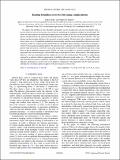Reading boundless error-free bits using a single photon
Author(s)
Guha, Saikat; Shapiro, Jeffrey H.
DownloadGuha-2013-Reading boundless error-free bits using a single photon.pdf (3.917Mb)
PUBLISHER_POLICY
Publisher Policy
Article is made available in accordance with the publisher's policy and may be subject to US copyright law. Please refer to the publisher's site for terms of use.
Terms of use
Metadata
Show full item recordAbstract
We address the problem of how efficiently information can be encoded into and read out reliably from a passive reflective surface that encodes classical data by modulating the amplitude and phase of incident light. We show that nature imposes no fundamental upper limit to the number of bits that can be read per expended probe photon and demonstrate the quantum-information-theoretic trade-offs between the photon efficiency (bits per photon) and the encoding efficiency (bits per pixel) of optical reading. We show that with a coherent-state (ideal laser) source, an on-off (amplitude-modulation) pixel encoding, and shot-noise-limited direct detection (an overly optimistic model for commercial CD and DVD drives), the highest photon efficiency achievable in principle is about 0.5 bits read per transmitted photon. We then show that a coherent-state probe can read unlimited bits per photon when the receiver is allowed to make joint (inseparable) measurements on the reflected light from a large block of phase-modulated memory pixels. Finally, we show an example of a spatially entangled nonclassical light probe and a receiver design—constructible using a single-photon source, beam splitters, and single-photon detectors—that can in principle read any number of error-free bits of information. The probe is a single photon prepared in a uniform coherent superposition of multiple orthogonal spatial modes, i.e., a W state. The code and joint-detection receiver complexity required by a coherent-state transmitter to achieve comparable photon efficiency performance is shown to be much higher in comparison to that required by the W-state transceiver, although this advantage rapidly disappears with increasing loss in the system.
Date issued
2013-06Department
Massachusetts Institute of Technology. Department of Electrical Engineering and Computer Science; Massachusetts Institute of Technology. Research Laboratory of ElectronicsJournal
Physical Review A
Publisher
American Physical Society
Citation
Guha, Saikat, and Jeffrey H. Shapiro. “Reading boundless error-free bits using a single photon.” Physical Review A 87, no. 6 (June 2013). © 2013 American Physical Society
Version: Final published version
ISSN
1050-2947
1094-1622